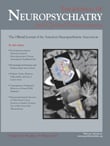Glioblastoma Multiforme Presenting as Treatment-Resistant Depression
To the Editor: Whereas brain neoplasm characteristically causes focal neurological disturbances, it is not uncommon for brain tumors to present with neurobehavioral changes in the absence of any localizing signs or deficits. We report a case of a 53-year-old man who presented with 10 years of treatment-resistant depression yet showed minimal neurological signs. Neuroimaging revealed a glioblastoma multiforme of the left frontal and parietal lobe. We thus emphasize the importance of considering neuroimaging studies in all patients presenting with atypical psychiatric symptoms regardless of a lack of neurological symptoms.
Case Report
The patient was a 53-year-old Caucasian man who presented with depressed mood, anhedonia, low energy, and insomnia. The patient had been diagnosed with depression since the age of 43. Prior to that he did not have any formal psychiatric history, but he reported a history of grand mal seizures that started at the age of 8. The patient had poor response to different trials of antidepressants, and due to decline in his level of functioning, inability to care for himself, and having suicidal thoughts, he had to be hospitalized. Routine laboratory work came back normal. Because of his poor response to antidepressants and the history of seizure disorder, brain imaging studies were warranted. A CT scan followed by MRI of the brain revealed a left frontal and temporal lobe mass with extension to right frontal lobe. Brain biopsy indicated a glioblastoma multiforme.
We hypothesize that the patient might have had an astrocytoma earlier in life, which presented with seizure disorder and then may have evolved to its more malignant form, the glioblastoma multiforme. Left frontal lobe lesions have been proven to cause depression; hence, treatment-resistant depression in this patient could be a consequence of the frontal lobe mass.
Discussion
Various neurological diseases can present as psychiatric disorders. Understanding underlying neuroanatomic function helps physicians to localize defects and search for many treatable neurological conditions, including brain tumors. 1 However, patients may have minimal or no neurological symptoms and signs, as in the case presented, and psychiatric symptoms may be the only clue. 2 Kohler and Burock 3 reported a case of a 35-year-old woman who presented with various psychiatric disorders but had limited response to psychopharmacological treatment. After treatment of the tumor, her mood stabilized and she was able to pursue work. Psychiatric manifestations secondary to brain tumors may span across all age groups from children to adults and the geriatric population.
In patients with previous psychiatric history, the picture is more complicated. Psychiatric patients may not be very verbal about their symptoms. In such cases, neuroimaging becomes especially crucial for facilitating the diagnosis.
Filley and Kleinschmidt-DeMasters 4 have attempted to correlate tumor location with neurobehavioral symptoms. In their case series, patients with frontal lobe tumors presented with abulia, personality change, or depression, whereas those with temperal limbic tumors had auditory and visual hallucinations, mania, or panic attacks. In Wellisch et al.’s 5 study, one of the key predictors of major depressive disorder was the frontal region tumor location. We concluded that it is important for physicians to have a high suspicion of brain tumors in patients with new-onset psychiatric symptoms. Early detection is of paramount importance for patient quality of life.
1. Skuster DZ, Dogre KB, Corbett JJ: Neurological conditions presenting as psychiatric disorders. Psychiatr Clin North Am 1992; 15:311–333Google Scholar
2. Gillespie JS, Craig JJ, McKinstry CS: Bilateral astrocytoma involving the limbic system precipitating disabling amnesia and seizures. Seizure 2000; 9:301–303Google Scholar
3. Kohler CG, Burock M: ECT for psychotic depression associated with a brain tumor. Am J Psychiatry 2001; 158:2089Google Scholar
4. Filley CM, Kleinschmidt-DeMasters BK: Neurobehavioral presentations of brain neoplasms. West J Med 1995; 163:19–25Google Scholar
5. Wellisch DK, Kaleita TA, Freeman D, et al: Predicting major depression in brain tumor patients. Psychooncology 2002; 3:230–238Google Scholar



